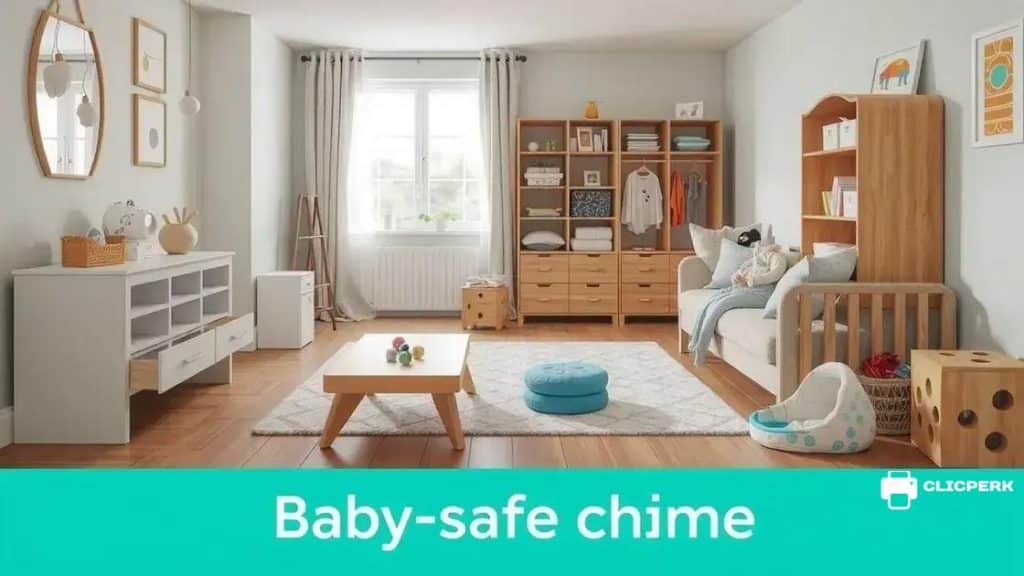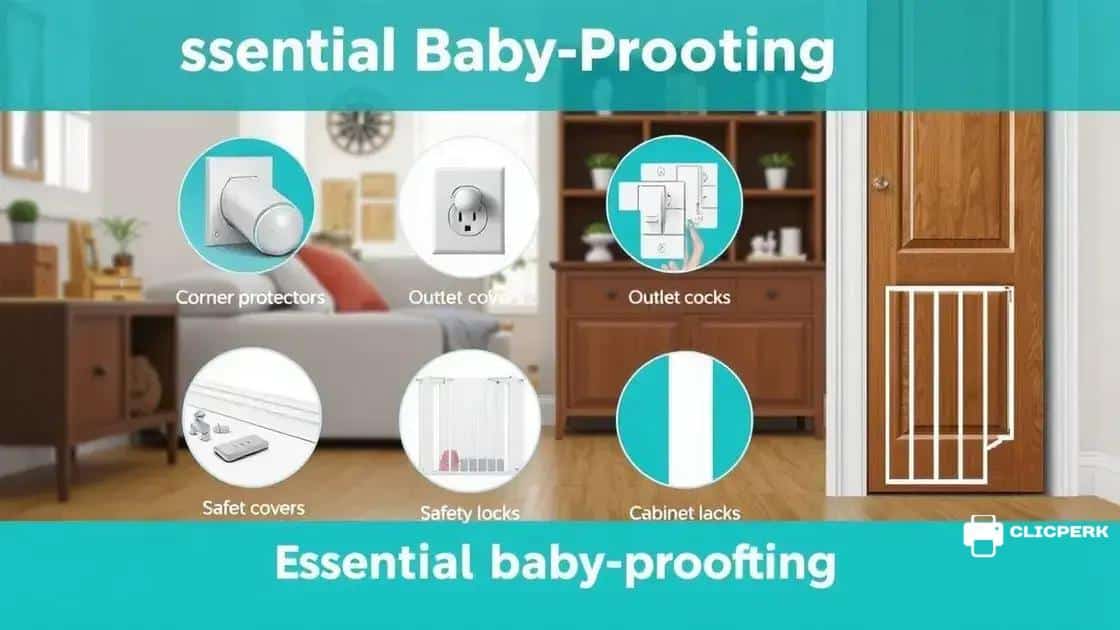Creating a baby-proof home: essential tips for safety

Anúncios
Creating a baby-proof home involves identifying hazards, using essential safety items, and regularly maintaining these measures to ensure a secure environment for your child to explore safely.
Creating a baby-proof home is vital for ensuring your little one’s safety. Have you thought about how your home can support a curious baby? Let’s dive into some essential strategies to keep your space secure.
Anúncios
Understanding the importance of baby-proofing
When it comes to creating a baby-proof home, understanding the importance of baby-proofing is critical. Every year, countless accidents happen in homes where babies and toddlers roam freely. These incidents can be easily avoided with proper safety measures.
Why Baby-Proofing Matters
Baby-proofing your home is not just a precaution; it ensures your child’s well-being. Babies are naturally curious and will explore every corner of their environment. By making your home safe, you allow them to discover without the risk of injury.
Key Reasons to Baby-Proof
- Accident Prevention: Simple steps can drastically reduce the chance of falls, cuts, and other accidents.
- Peace of Mind: Knowing your environment is safe helps you relax, allowing you to enjoy your time with your baby.
- Encourages Independence: A safe space helps your child explore freely, fostering confidence and skills.
Moreover, baby-proofing helps you create a controlled space where your child can learn and grow. It’s not just about blocking dangers; it’s also about engaging your child with safe options. For example, while you might restrict access to stairs, providing safe toys nearby allows for safe play.
Anúncios
Incorporating safety methods like installing outlet covers, securing heavy furniture, and covering sharp edges can significantly impact your child’s safety. These adjustments don’t have to be time-consuming. They can be done gradually to fit your schedule while ensuring a secure environment.
Common hazards in your home
Identifying common hazards in your home is an essential step in creating a safe environment for your baby. Many everyday items can pose risks that may not be immediately obvious. By understanding these dangers, you can take proactive measures to minimize accidents.
Understanding Common Household Hazards
Various hazards can be found in different areas of your home. It’s vital to be aware of these risks to keep your little one safe. Paying attention to your surroundings will help you spot potential danger zones.
Risky Areas in Your Home
- Sharp Objects: Knives, scissors, and other sharp tools should always be kept out of reach.
- Furniture Edges: Tables and other furniture with sharp corners can cause injuries if a child falls.
- Electrical Outlets: Exposed outlets can be a shock hazard, so using covers is essential.
- High Places: Items stored on shelves or countertops can easily fall and harm a curious child.
Another significant risk is the presence of small items that can be choking hazards. Things like coins, buttons, or small toys should be securely stored away. Additionally, chemicals and cleaning supplies need to be kept locked up, as they can be poisonous if ingested.
Keeping an eye on your baby’s movements can also reveal potential hazards. As babies start crawling and walking, they explore with eagerness. You’ll want to remove anything that could lead to trips or falls.
Lastly, remember to consider outdoor hazards as well. For instance, balconies and stairs can be dangerous without proper barriers. Ensuring safe access points in your yard or garden is also essential.
Essential baby-proofing items to consider

When it comes to essential baby-proofing items, knowing what to consider is key to safeguarding your home. There are various products designed to protect your little one from potential hazards. Having the right tools can make a significant difference in ensuring your baby’s safety.
Must-Have Baby-Proofing Products
Start by assessing the areas in your home that need extra attention. Focus on key locations like the living room, kitchen, and nursery. Here are some essential items to include:
- Corner Protectors: These are soft pads that attach to sharp furniture edges to prevent injuries.
- Cabinet and Drawer Locks: These keep curious hands from accessing harmful items like cleaning supplies.
- Outlet Covers: These are crucial for preventing electric shocks from exposed outlets.
- Safety Gates: Install these at stairways or doorways to restrict access to unsafe areas.
Having a combination of these products will help you manage potential risks effectively. But baby-proofing goes beyond just installation; it requires ongoing attention. As your child grows, their curious nature will lead them to explore new areas.
Regularly Assessing Your Environment
Regular assessments of your household will ensure your baby-proofing measures remain effective. What worked for a crawling infant may not be sufficient for a toddling one. Remain flexible and ready to adapt your safety measures as your child develops.
Aside from the items mentioned, consider other additions like safety straps for heavy furniture, non-slip mats in the bathroom, and house plants that are safe for children. Every element contributes to a safer environment, reducing risks significantly.
Steps to baby-proof each room
Implementing steps to baby-proof each room is essential for ensuring your child’s safety at home. Each area in the house presents unique challenges and requires specific strategies. Let’s explore how to tackle this task efficiently.
Living Room Safety
The living room is often a central gathering spot, and it’s crucial to make it safe. Start by securing heavy furniture like bookshelves and TV stands to prevent them from tipping over. Additionally, keep cords from blinds and electronics out of reach, as they can present choking or strangulation hazards.
Kitchen Precautions
The kitchen poses many risks for little ones. Install cabinet locks to keep dangerous items, such as cleaning supplies and sharp utensils, inaccessible. Always use back burners when cooking and turn pot handles inward to prevent accidental spills.
- Use stove guards: These are barriers that can prevent curious toddlers from reaching hot surfaces.
- Keep small appliances unplugged: This avoids accidental activation when your baby starts exploring.
- Store knives and scissors safely: Always keep them in drawers or cabinets that your child cannot access.
Now, moving to the bathrooms, it’s crucial to install non-slip mats in both the tub and on the floor. Use toilet locks to prevent your child from accessing the toilet and drowning. Keep any medicines and toiletries high up and out of reach.
Bedroom Safety
In the nursery or bedroom, make sure to have a crib that meets current safety standards. Avoid placing any toys or soft bedding inside the crib to reduce the risk of suffocation. Secure furniture that could tip over, like dressers, to the wall to protect your baby as they learn to stand and walk.
By focusing on these proactive measures, you’ll create a safer environment that allows your child to explore freely while minimizing risks of accidents. As your child grows, it’s important to continue reassessing and adapting your baby-proofing strategies.
Tips for maintaining a baby-proof environment
Maintaining a baby-proof environment requires ongoing effort and vigilance. As your child grows and develops new skills, your safety measures may need to adapt. Here are some effective tips to ensure your home remains a safe space.
Regularly Inspect Safety Measures
Regular inspections of your baby-proofing can help you catch any potential issues before they become hazards. Check all safety gates and locks to ensure they are functioning properly. Look for signs of wear and tear, especially on items like corner protectors and outlet covers.
Stay Organized
A clutter-free environment contributes significantly to safety. Keep toys organized and out of pathways to prevent trips. Utilize storage solutions that keep hazardous items hidden from view. This not only creates a safer space but also makes it easier for you to supervise your baby.
- Designate Safe Play Areas: Create specific areas for your child to play safely. Use rugs or soft mats to cushion falls.
- Use Non-Toxic Products: Choose non-toxic, baby-safe materials for furniture and toys to ensure your child’s health.
- Educate Older Siblings: If your baby has older siblings, teach them about safety and how to properly interact with their younger sibling.
Another crucial aspect is being mindful of visitors. Ensure that guests are aware of your baby-proofing measures. Remind them not to leave items like purses or bags within reach, as they could contain choking hazards or harmful substances.
As children grow, adapt your baby-proofing measures to fit their developmental changes. For instance, as they learn to climb, it may be necessary to reassess safety gates or secure furniture differently.
FAQ – Frequently Asked Questions about Creating a Baby-Proof Home
What are the essential baby-proofing items I should have in my home?
Some essential items include corner protectors, cabinet locks, outlet covers, and safety gates to keep your baby safe.
How often should I check my baby-proofing measures?
It’s important to regularly inspect your baby-proofing measures, ideally every few months, to ensure everything is still secure and functioning.
What should I do if my baby starts to climb furniture?
If your baby starts climbing, it’s essential to secure heavy furniture to the wall and remove items they can use to climb higher.
How can I create a safe play area for my child?
Designate a specific area for play, use soft mats or rugs, and make sure to remove any hazards like sharp objects or small items that could be choking risks.





